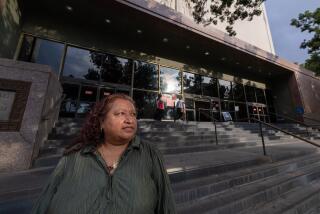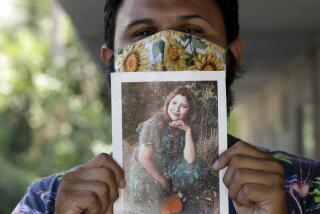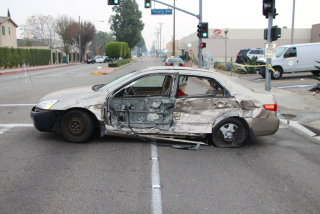Backlog in Santa Monica Court Drops With ‘Crash’
The doctor and the woman suing him for malpractice remained far apart on the amount of money each found acceptable as a settlement.
The two-lawyer panel serving as referees in the case seemed sympathetic to the woman, but unable to budge the doctor’s attorney or persuade the hospital to chip in on the settlement.
“You play tough guy for awhile,” one of the lawyer-referees said to the other as the litigants were brought in for another round of talks. “You’re a good tough guy.”
But in the end, the case was chalked up as one that could not be resolved in a special three-week “crash settlement” program in Santa Monica Superior Court.
Reducing Backlog
The program, entering its final week tomorrow, is designed to chisel away at the huge backlog of civil cases before the court. And, despite several difficult cases, the program is scoring successes, Superior Court Judge Richard G. Harris said.
Harris, coordinator of the program, said about 160 lawyers and retired judges donated their time to serve on the two-member referee panels. They are hearing about 450 cases in mandatory hourlong settlement conferences.
The program is one of numerous mediation efforts courts are employing to relieve congested dockets. Because criminal cases must be given priority, civil cases in Los Angeles County Superior Court often take years to reach trial. The County Bar Assn. has sued the court system, contending that it does not process civil cases fast enough.
Harris said the crash settlement program is different from similar mediation efforts because participation by litigants is mandatory and because the referees are volunteer lawyers instead of judges or court officers.
Harris reported a success rate higher than he had projected.
‘Significant’ Benefits
“I think the program is going very well . . . and the continuing benefits will be very significant,” Harris said in an interview.
“What we are doing is reducing the number of cases (awaiting trial) so that there is a reasonable chance . . . of getting the calendar down to such a size so that people will have a reasonable expectation that they can really get a trial,” he said. “And we are definitely making progress.”
Of 259 cases heard in the program’s first nine days, about 36%, or 94 cases, were settled or otherwise removed from the court’s dockets, Harris said. His tally showed that another 111 cases were not settled, 50 were excused or rescheduled and four involved “partial settlements.”
Harris said many of the lawyers serving as referees volunteered to do it again, and were urging him to begin holding a crash program twice a year.
In interviews, many of the lawyer-referees sang the crash program’s praise.
While they recognized that they can only do so much toward settling cases, they said any effort that helps to thin out the court’s backlog is beneficial to plaintiffs, defendants and the judicial system.
System Breaking Down
“The court system is breaking down under the weight of so many cases and too few judges,” said lawyer John M. Maller, who served as a referee.
“Whatever can be done to make it better should be done. When it takes five years or longer to get to trial . . . the truly injured are not compensated,” he said. “I believe in the system, but it’s not working now.”
Once in awhile, the crash settlement program hit a snag. In one case, a lawyer representing Santa Monica Hospital in a malpractice suit balked at participating.
The attorney, Jeffery Grass, challenged the court’s authority to empower volunteer lawyers to hear cases or oversee settlements. He appeared to echo the complaints of a small number of attorneys who said a judge, not fellow lawyers, is best equipped to settle cases.
“There is no jurisdiction to assign a settlement conference proceeding to two non-judicial referees,” Grass said in an interview. “If this had been voluntary, I would have no objection.”
Grass also complained that the order to appear at the crash program interrupted his preparation for an already-scheduled voluntary settlement conference before a judge in March.
Judge Harris donned his robes and, in a 20-minute hearing, drew an analogy for Grass and his client: Having lawyers serve as referees to settle lawsuit cases is much like a hospital using candy-stripers to volunteer in patients’ health care.
Grass agreed to withdraw the challenge “for expediency’s sake.” However, the case was not settled and was rescheduled for another settlement conference--but this time with the judge presiding.
The short-lived challenge underscored the fact that some cases simply cannot be settled in this sort of program.
“The program only works with cases that can be settled,” said attorney Judith Gelfand, another volunteer referee. “In any case where one (side) refuses to pay money for reasons extrinsic to the case, because it might be (company) policy . . . then there’s nothing we can do here.”
Benefits of Program
However, she said the program has its rewards, even when settlements are not reached.
“Even if you don’t resolve the case, you focus on issues and that may help later,” Gelfand said. “Even if we don’t have direct impact today, there may be a little push toward settlement.”
Most of the settlements stall over money--how much will the defendant pay and the plaintiff accept. When an impasse is reached, Harris usually meets with each party privately in his office.
“I don’t put pressure on anybody,” Harris told the defendants in one case. “I’m not a shouter or a pounder. I just explain the system the way it works (and) the advantages to doing it this way.”
One defense team was fined $500 when it appeared for its conference unprepared, Harris said. Any party who fails to show up without a good reason or is unprepared risks a similar fine, he said.
When settlements are not reached, the two referees fill out forms assessing the case and reporting how much money they believe the defendant will pay and the plaintiff will accept.
Those forms are locked away until the case comes before a judge. The work helps the judge quickly pinpoint the problems involved in the case, Harris said.
Some of the litigants seemed to have mixed feelings about participating.
Paul Bruckner Jr., whose mother is suing Santa Monica Hospital in the 1985 death of her husband, said he thought a satisfactory settlement was unlikely and conceded he believed his family’s case might get a better hearing at a trial.
But he added, “At least it (the crash settlement program) gets the lawyers together, and it’s good for the client to see something getting done.”
More to Read
Sign up for Essential California
The most important California stories and recommendations in your inbox every morning.
You may occasionally receive promotional content from the Los Angeles Times.











